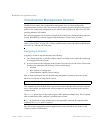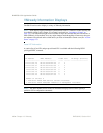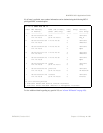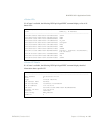
BLADEOS 6.5.2 Application Guide
178 Chapter 13: VMready BMD00220, October 2010
VM Policy Bandwidth Control
Note – VM policy bandwidth control is supported only when the switch is operating with the
Default deployment profile (see “Deployment Profiles” on page 147). If using the Routing profile,
VM policy bandwidth control commands will not be available.
In a virtualized environment where VEs can migrate between hypervisors and thus move among
different ports on the switch, traffic bandwidth policies must be attached to VEs, rather than to a
specific switch port.
VM Policy Bandwidth Control allows the administrator to specify the amount of data the switch
will permit to flow from a particular VE, without defining a complicated matrix of ACLs or
VMAPs for all port combinations where a VE may appear.
VM Policy Bandwidth Control Commands
VM Policy Bandwidth Control can be configured using the following configuration commands:
Bandwidth allocation can be defined for transmit (TX) traffic only. Because bandwidth allocation is
specified from the perspective of the VE, the switch command for TX Rate Control (txrate) sets
the data rate to be sent from the VM to the switch.
The committed rate is specified in multiples of 64 kbps, from 64 to 10,000,000. The maximum burst
rate is specified as 32, 64, 128, 256, 1024, 2048, or 4096 kb. If both the committed rate and burst are
set to 0, bandwidth control will be disabled.
When txrate is specified, the switch automatically selects an available ACL for internal use with
bandwidth control. Optionally, if automatic ACL selection is not desired, a specific ACL may be
selected. If there are no unassigned ACLs available, txrate cannot be configured.
RS G8124(config)# virt vmpolicy vmbwidth <VM MAC>|<index>|<UUID>|
<IPv4 address>|<name> ?
txrate <committed rate> <burst> [<ACL number>] (Set the VM to switch rate)
bwctrl (Enable bandwidth control)


















